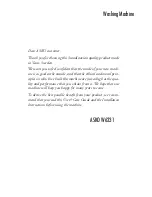
© 2022 Staheli West
84
Judging Bale Moisture Visually
Judging Bale Moisture Visually
You should always observe the bales within a field while you are baling.
● Bales with proper moisture levels will exhibit the following characteristics:
□ Leaf Pattern
•
Leaves should be attached to stem and/or somewhat “wafered” into the flakes in the bale.
•
The front (plunger end) of the bale represents the top of the windrow of hay and will normal-
ly not look as good as the rear end of the bale, simply because of the action of the plunger
against the front face of the bale on each plunger/stuffer stroke. When observing the front
of the bale, you should expect a little surface damage from the plunger. However, if you brush
away the surface, you should see a good leaf pattern.
•
The rear end of the bale represents the bottom of the
windrow of hay and will normally show
less mechanical damage since the plunger does not come in direct contact with it. When ob-
serving the rear end of a bale with the correct moisture level, you should expect an excellent
leaf pattern. Leaves should be attached to stem and/or somewhat “wafered” into the flakes in
the bale.
□ Bale Conformation
•
The sides of bales with a good moisture level should be compressed, smooth, and may be slick
but of good color.
•
Bale shape should be consistent, with firm corners and ends.
□
Bale Color
•
The sides of bales with a good moisture level should be compressed, smooth, and may be slick
but of good color.
● Bales that are too dry will exhibit one or more of the following characteristics:
□ Appear ragged and shattered along the sides
□
Leaves will be detached from stems
□ Corners and ends will be soft
□
Bale weights will be low
● Bales that are too high in moisture will exhibit one or more of the following characteristics:
□
Sides of bale may be dark or slightly discolored, and slick or smeared
□ Leaf retention will be good, but the flakes in the bale may be caked too tightly
NOTE: There is an acceptable range of moisture where bale density, flake wafering and other characteristics
can be manipulated and controlled according to the demands of your hay market. You should become familiar
with these characteristics.
















































